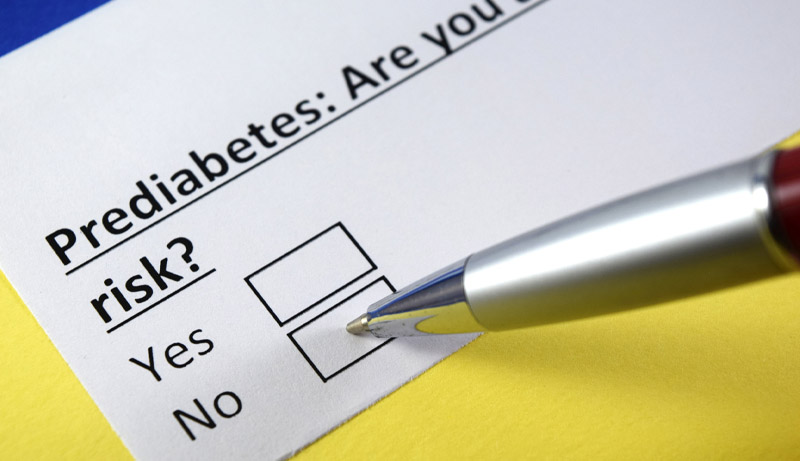Can You Reverse Your Prediabetes?

Diabetes by the Numbers
The diabetes numbers in the United States are staggering. The Centers for Disease Control and Prevention indicates that 34.2 million adults in the U.S. are living with diabetes, a number that has more than doubled over the past 20 years, with one in five not even knowing they have it. Diabetes is the leading cause of kidney failure, adult blindness and lower limb amputation. But the number of people who are prediabetic, meaning they have a higher-than-normal blood sugar level, is nearly one in four Americans and more than three-quarters of them are unaware of their risk. Take this CDC diabetes risk assessment to see if you may be one of the 88 million Americans whose blood sugar is elevated enough to be considered prediabetic https://www.cdc.gov/diabetes/prevention/pdf/Prediabetes-Risk-Test-Final.pdf
Type 1 diabetes, often diagnosed in children and young adults is where your body does not make its own insulin. The insulin helps cells in use up the glucose from blood. According to the CDC, a normal blood sugar level is below 140. A person is considered to be prediabetic with a blood sugar level of 140-199. A blood sugar level of 200 or above would be qualified as type 2 diabetes. Those diagnosed with type 2 diabetes are normally adults when diagnosed. Their bodies do not use insulin well and that caused their blood sugar levels to fluctuate. Those who may be prediabetic, their insulin is not working properly and too much glucose builds up in the blood.
In Somers Point, Shore Physicians Group registered dietitian and certified diabetes educator Tiffany Rios said while the patient’s blood sugar level may not be high enough to be considered type 2 diabetes yet, without lifestyle changes, adults and children with prediabetes are more likely to develop type 2 diabetes.
Don’t Just Blame the Genes
Rios said, “Much like diabetes, genetics does play a role in prediabetes. But environment and lifestyle are key and they can reverse the diabetes process or they can push it toward type 2 diabetes.” So what are the steps to take to avoid developing diabetes?
Rios said, “Exercise and diet are key. Exercise helps the muscle cells absorb glucose (sugar) more efficiently, thereby normalizing the blood sugar level. Consuming healthy portions and watching the types of carbohydrates make a big impact on our ability to normalize glucose levels.”
Sugar Lurks in Many Places
Added sugars are a big culprit that factor into people developing type 2 diabetes, according to Rios. “Added sugars and refined carbohydrates like enriched wheat flour, processed foods like cereal, crackers, pretzels, cookies, breads, pizza, pancakes, waffles, donuts, cakes, pie and ice cream are obvious foods that contribute to type 2 diabetes. But there are also some not so obvious foods that contain added sugars like ketchup, sauces, dressings and yogurts.”
Rios said a balanced diet coupled with an exercise regime can prevent type 2 diabetes from developing. If someone has been diagnosed with type 2 diabetes, it most certainly can help a person to manage their diabetes.
The Job of Insulin
As Rios explained, “Insulin is a hormone that is responsible for helping us utilize the sugar (glucose) from the food we eat. When we eat too many carbohydrates or highly processed carbohydrates it spikes the amount of sugar in the blood and forces insulin to work a bit harder to normalize our blood sugar level. It can also desensitize our cells to insulin if our blood sugar continues to spike. Insulin acts as a lock and key. It has the key to our cells where the food digested from the stomach is then absorbed into the cells and tissue”
Why Diabetes is so damaging to Heart and Kidneys?
Diabetes takes a real toll on the body. “When blood sugar levels are high, our blood can run like molasses. This viscous blood damages the arteries and capillaries feeding our major organs-the heart, nervous system and kidneys” said Rios.
Help Yourself
Consuming moderate levels of carbohydrates and tailoring them to your activity level are Rios suggestions to keep type 2 diabetes as bay. “A good place to start is 100-150 grams a day,” according to Rios. “Vegetables and proteins are two potent fighters against type 2 diabetes because they help us to absorb sugar at a slower pace, which improves insulin sensitivity and the ability to burn carbohydrates as fuel.”
Start keeping a food journal. Rios said, “A food journal is incredibly helpful for noting patterns between what foods are spiking your blood pressure. It gives direct feedback on how you are doing daily. You can use a food journal to count your carbs and ensure you are getting enough protein and fiber from vegetables.”
For help getting your blood sugar under control, creating your food journal and keeping your prediabetes from becoming type 2 diabetes, make an appointment with Tiffany Rios at 609-365-5300.